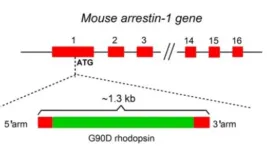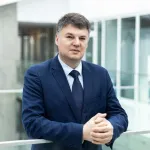(Press-News.org) If you zoom in on a chemical reaction to the quantum level, you’ll notice that particles behave like waves that can ripple and collide. Scientists have long sought to understand quantum coherence, the ability of particles to maintain phase relationships and exist in multiple states simultaneously; this is akin to all parts of a wave being synchronized. It has been an open question whether quantum coherence can persist through a chemical reaction where bonds dynamically break and form.
Now, for the first time, a team of Harvard scientists has demonstrated the survival of quantum coherence in a chemical reaction involving ultracold molecules. These findings highlight the potential of harnessing chemical reactions for future applications in quantum information science.
“I am extremely proud of our work investigating a very fundamental property of a chemical reaction where we really didn’t know what the result would be,” said senior co-author Kang-Kuen Ni, Theodore William Richards Professor of Chemistry and Professor of Physics. “It was really gratifying to do an experiment to find out what Mother Nature tells us.”
In the paper, published in Science, the researchers detailed how they studied a specific atom-exchange chemical reaction in an ultra-cold environment involving 40K87Rb bialkali molecules, where two potassium-rubidium (KRb) molecules react to form potassium (K2) and rubidium (Rb2) products. The team prepared the initial nuclear spins in KRb molecules in an entangled state by manipulating magnetic fields and then examined the outcome with specialized tools. In the ultra-cold environment, the Ni Lab was able to track the nuclear spin degrees of freedom and to observe the intricate quantum dynamics underlying the reaction process and outcome.
The work was undertaken by several members of Ni’s Lab, including Yi-Xiang Liu, Lingbang Zhu, Jeshurun Luke, J.J. Arfor Houwman, Mark C. Babin, and Ming-Guang Hu.
Utilizing laser cooling and magnetic trapping, the team was able to cool their molecules to just a fraction of a degree above Absolute Zero. In this ultracold environment, of just 500 nanoKelvin, molecules slow down, enabling scientists to isolate, manipulate, and detect individual quantum states with remarkable precision. This control facilitates the observation of quantum effects such as superposition, entanglement, and coherence, which play fundamental roles in the behavior of molecules and chemical reactions.
By employing sophisticated techniques, including coincidence detection where the researchers can pick out the exact pairs of reaction products from individual reaction events, the researchers were able to map and describe the reaction products with precision. Previously, they observed the partitioning of energy between the rotational and translational motion of the product molecules to be chaotic [Nature 593, 379-384 (2021)]. Therefore, it is surprising to find quantum order in the form of coherence in the same underlying reaction dynamics, this time in the nuclear spin degree of freedom.
The results revealed that quantum coherence was preserved within the nuclear spin degree of freedom throughout the reaction. The survival of coherence implied that the product molecules, K2 and Rb2, were in an entangled state, inheriting the entanglement from the reactants. Furthermore, by deliberately inducing decoherence in the reactants, the researchers demonstrated control over the reaction product distribution.
Going forward, Ni hopes to rigorously prove that the product molecules were entangled, and she is optimistic that quantum coherence can persist in non-ultracold environments.
“We believe the result is general and not necessarily limited to low temperatures and could happen in more warm and wet conditions,” Ni said. “That means there is a mechanism for chemical reactions that we just didn’t know about before.”
First co-author and graduate student Lingbang Zhu sees the experiment as an opportunity to expand people’s understanding about chemical reactions in general.
“We are probing phenomena that are possibly occurring in nature,” Zhu said. “We can try to broaden our concept to other chemical reactions. Although the electronic structure of KRb might be different, the idea of interference in reactions could be generalized to other chemical systems as well.”
END
Finding quantum order in chaos
2024-05-16
ELSE PRESS RELEASES FROM THIS DATE:
Study suggests high-frequency electrical ‘noise’ results in congenital night blindness
2024-05-16
In what they believe is a solution to a 30-year biological mystery, neuroscientists at Johns Hopkins Medicine say they have used genetically engineered mice to address how one mutation in the gene for the light-sensing protein rhodopsin results in congenital stationary night blindness.
The condition, present from birth, causes poor vision in low-light settings.
The findings, published May 14 in Proceedings of the National Academy of Sciences, demonstrate that the rhodopsin gene mutation, called ...
TeltoHeart wristband, developed by Lithuanians, receives important medical device certification
2024-05-16
Teltonika’s TeltoHeart, a multifunctional smart wristband system developed in cooperation between Lithuanian industry and universities has been given the CE MDR (Class IIa) medical device certification. This approval confirms that the product meets the comprehensive quality standards for medical devices and opens up new markets worldwide for this innovative product.
"This is an important recognition that we have been working towards since the start of this project in 2020. The CE MDR certification proves that TeltoHeart is a safe ...
Unique brain circuit is linked to Body Mass Index
2024-05-16
· One region is related to olfaction and reward, the other to negative feelings like pain · When the connection between these brain regions is weak, people have higher BMI
· Food may continue to be rewarding, even when these individuals are full
CHICAGO --- Why can some people easily stop eating when they are full and others can’t, which can lead to obesity?
A Northwestern Medicine study has found one reason may be a newly discovered structural connection ...
Noise survey highlights need for new direction at Canadian airports #ASA186
2024-05-16
OTTAWA, Ontario, May 16, 2024 – The COVID-19 pandemic changed life in many ways, including stopping nearly all commercial flights. At the Toronto Pearson International Airport, airplane traffic dropped by 80% in the first few months of lockdown. For a nearby group of researchers, this presented a unique opportunity.
Julia Jovanovic will present the results of a survey conducted on aircraft noise and annoyance during the pandemic era Thursday, May 16, at 11:10 a.m. EDT as part of a joint meeting of the Acoustical Society of America and ...
COSPAR partners with LASP for 1st COSPAR Center of Excellence
2024-05-16
Partnering with LASP was an obvious decision for COSPAR. LASP stands out with its distinguished track record in space science research, having deployed scientific instruments to every planet in our solar system, the Sun and numerous moons. In particular, LASP has been at the forefront of pioneering Cube-Sat missions, consistently achieving remarkable success in gathering scientific data. With seven completed CubeSat missions and nine more in active development or orbit, LASP has demonstrated unparalleled expertise in this field. ...
Building a better sarcasm detector #ASA186
2024-05-16
OTTAWA, Ontario, May 16, 2024 – Oscar Wilde once said that sarcasm was the lowest form of wit, but the highest form of intelligence. Perhaps that is due to how difficult it is to use and understand. Sarcasm is notoriously tricky to convey through text — even in person, it can be easily misinterpreted. The subtle changes in tone that convey sarcasm often confuse computer algorithms as well, limiting virtual assistants and content analysis tools.
Xiyuan Gao, Shekhar Nayak, and Matt Coler of Speech Technology Lab at the University of Groningen, Campus Fryslân developed a multimodal algorithm ...
Natural toxins in food: Many people are not aware of the health risks
2024-05-16
Many people are concerned about residues of chemicals, contaminants or microplastics in their food. However, it is less well known that many foods also contain toxins of completely natural origin. These are often chemical compounds that plants use to ward off predators such as insects or microorganisms. These substances are found in beans and potatoes, for example, and can pose potential health risks. However, according to a recent representative survey by the German Federal Institute for Risk Assessment (BfR), only just under half of the respondents (47 per cent) were even aware of plant toxic substances. The BfR Consumer Monitor Special on naturally occurring plant toxins ...
Archaeology: Egyptian pyramids built along long-lost Ahramat branch of the Nile
2024-05-16
31 pyramids in Egypt, including the Giza pyramid complex, may originally have been built along a 64-km-long branch of the river Nile which has long since been buried beneath farmland and desert. The findings, reported in a paper in Communications Earth & Environment, could explain why these pyramids are concentrated in what is now a narrow, inhospitable desert strip.
The Egyptian pyramid fields between Giza and Lisht, built over a nearly 1,000-year period starting approximately 4,700 years ago, now sit on the edge of the inhospitable Western Desert, part of the Sahara. ...
Effectiveness of a web-based cognitive behavioral self-help intervention for binge eating disorder
2024-05-16
About The Study: In this randomized clinical trial of a web-based self-help intervention for patients with binge eating disorder, the findings confirmed its effectiveness in reducing binge eating episodes and improving various mental health outcomes, highlighting a scalable solution to bridge the treatment gap for this condition.
Corresponding Author: To contact the corresponding author, Luise Pruessner, M.S., email luise.pruessner@psychologie.uni-heidelberg.de.
To access the embargoed study: Visit our For The Media website at this link ...
Physician and AI chatbot responses to cancer questions from social media
2024-05-16
About The Study: The findings of this study suggest that chatbots can generate quality, empathetic, and readable responses to patient questions comparable to physician responses sourced from an online forum. Further research is required to assess the scope, process integration, and patient and physician outcomes of chatbot-facilitated interactions.
Corresponding Author: To contact the corresponding author, Srinivas Raman, M.D., M.A.Sc., email srinivas.raman@rmp.uhn.ca.
To access the embargoed study: Visit ...



